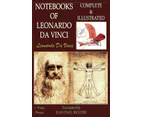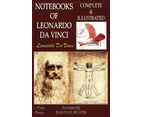The Notebooks of Leonardo Da Vinci: Complete & Illustrated - Jean Paul Richter

This new Great collection of his art and notes from Cheapest Books. Put together all notes and drawings of Da Vinci as found, not need reordered. A singular fatality has ruled the destiny of nearly all the MOST FAMOUS OF LEONARDO DA VINCIS WORKS. Two of the three most important were never completed, obstacles having arisen during his life-time, which obliged him to leave them unfinished; namely the Sforza Monument and the Wall-painting of the Battle of Anghiari, while the thirdthe picture of the Last Supper at Milanhas suffered irremediable injury from decay and the repeated restorations to which it was recklessly subjected during the XVIIth and XVIIIth centuries. Nevertheless, no other picture of the Renaissance has become so wellknown and popular through copies of every description. Vasari says, and rightly, in his Life of Leonardo, "that he laboured much more by his word than in fact or by deed", and the biographer evidently had in his mind the numerous works in Manuscript which have been preserved to this day. To us, now, it seems almost inexplicable that these valuable and interesting original texts should have remained so long unpublished, and indeed forgotten. It is certain that during the XVIth and XVIIth centuries their exceptional value was highly appreciated. This is proved not merely by the prices which they commanded, but also by the exceptional interest which has been attached to the change of ownership of merely a few pages of Manuscript. Leonardos literary labours in various departments both of Art and of Science were those essentially of an enquirer, hence the analytical method is that which he employs in arguing out his investigations and dissertations. The vast structure of his scientific theories is consequently built up of numerous separate researches, and it is much to be lamented that he should never have collated and arranged them. His love for detailed researchas it seems to mewas the reason that in almost all the Manuscripts, the different paragraphs appear to us to be in utter confusion; on one and the same page, observations on the most dissimilar subjects follow each other without any connection. A page, for instance, will begin with some principles of astronomy, or the motion of the earth; then come the laws of sound, and finally some precepts as to colour. Another page will begin with his investigations on the structure of the intestines, and end with philosophical remarks as to the relations of poetry to painting; and so forth. Leonardo himself lamented this confusion, and for that reason I do not think that the publication of the texts in the order in which they occur in the originals would at all fulfil his intentions. No reader could find his way through such a labyrinth; Leonardo himself could not have done it. Added to this, more than half of the five thousand manuscript pages which now remain to us, are written on loose leaves, and at present arranged in a manner which has no justification beyond the fancy of the collector who first brought them together to make volumes of more or less extent. Nay, even in the volumes, the pages of which were numbered by Leonardo himself, their order, so far as the connection of the texts was concerned, was obviously a matter of indifference to him. The only point he seems to have kept in view, when first writing down his notes, was that each observation should be complete to the end on the page on which it was begun.
P>Review "All sciences are vain and full of errors that are not born of Experience, the mother of all Knowledge.""I awoke only to find that the rest of the world was still asleep.""Man has much power of discourse which for the most part is vain and false; animals have but little, but it is useful and true, and a small truth is better than a great lie." Leonardo da Vinci, Leonardos Notebooks About the Author: Leonardo Da Vinci, Born on April 15, 1452, in Vinci, Italy, Leonardo da Vinci was concerned with the laws of science and nature, which greatly informed his work as a painter, sculptor, inventor and draftsmen. His ideas and body of work-which includes "Virgin of the Rocks," "The Last Supper," "Leda and the Swan" and "Mona Lisa"-have influenced countless artists and made da Vinci a leading light of the Italian Renaissance. Quotes "Iron rusts from disuse, stagnant water loses its purity and in cold weather becomes frozen; even so does inaction sap the vigor of the mind." - Leonardo da Vinci Humble Beginnings Leonardo da Vinci was born on April 15, 1452, in Vinci, Italy. Born out of wedlock, the love child of a respected notary and a young peasant woman, he was raised by his father, and his stepmothers. The Last Supper In 1482, Lorenzo de Medici, a man from a prominent Italian family, commissioned da Vinci to create a silver lyre and bring it to Ludovico il Moro, the Duke of Milan, as a gesture of peace. Da Vinci did so and then wrote Ludovico a letter describing how his engineering and artistic talents would be of great service to Ludovicos court. His letter successfully endeared him to Ludovico, and from 1482 until 1499, Leonardo was commissioned to work on a great many projects. It was during this time that da Vinci painted "The Last Supper." Mona Lisa Da Vincis most well-known painting, and arguably the most famous painting in the world, the "Mona Lisa," was a privately commissioned work and was completed sometime between 1505 and 1507. Of the paintings wide appeal, James Beck, an art historian at Columbia University, once explained, "It is the inherent spirituality of the human creature that Leonardo was able to ingenuine to the picture that raises the human figure to some kind of majesty." Its been said that the Mona Lisa had jaundice, that she was a pregnant woman and that she wasnt actually a woman at all, but a man in drag. Based on accounts from an early biographer, however, the "Mona Lisa" is a picture of Lisa Gioconda, the real-life wife of a merchant, but thats far from certain. For da Vinci, the "Mona Lisa" was forever a work in progress, as it was his attempt at perfection. The painting was never delivered to its commissioner; da Vinci kept it with him until the end of his life. Today, the "Mona Lisa" hangs in the Louvre Museum in Paris, France, secured behind bulletproof glass, and is regarded as a priceless national treasure.

